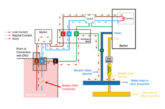
In this follow up to last month’s article, Viktors Nikolajevs, CTEK’s Skillbase Manager in the UK, answers more of the key questions that installers are commonly raising around EV charge point installations.
Installers at our UK training sessions will ask a lot of questions when they’re learning how to best install EV charge points. But, there are certain topics that will crop up time and again at training events up and down the country.
In my experience, installers are keen to find out all about EV charging, how the charging units work and the steps to effective installations. They’re an inquisitive lot and ask some very good questions at each session.
Last month I covered questions relating to EV charge point RCD protection, IK impact ratings and AC & DC chargers. This month I’ll broach two more questions:
Q. Which type of load management is needed?
Introduction of any EVSE equipment to a property will inevitably add additional strain onto the supply network and the local installation itself. It is important to understand what the maximum demand of the property is prior to installation of charging points. It is also important to remember that diversity cannot be applied to EVSE since it will operate at the rated level continuously, unless limited through configuration or instructed otherwise by the vehicle.
BS 7671:2018+A2:2022 Section 722.311.201 states that load curtailment, including reduction or disconnection, either automatically or manually, can be taken into consideration when determining the maximum demand of the installation. In many situations manual load reduction (through configuration) can impede the user experience when charging vehicles, so automatic approaches through load management equipment or software would be more appropriate.
There are two variations of load management solutions available – static and dynamic. Dynamic load management typically includes installation of additional meters and/or current transformers to the incoming supply to measure the overall power consumption of the property. The measured values would then be assessed by the EVSE or the load management controller, allowing the EVSE to use the remainder of the supply to charge the EV.
Furthermore, DNOs may require dynamic load management to be installed if the Maximum Demand thresholds, explained in Energy Network Association (ENA) Electric Vehicle Charge Point and Heat Pump Connections Process, are reached or if local transformers have limited capacity.
Static load management can be used in installations where the actual power consumption of the property is known and is relatively stable. The power consumption of the property does not need to be measured continuously, so there is no need for additional meters or CTs, and there is a dedicated amount of power capacity dedicated only for vehicle charging. The load management is then carried out against this dedicated power capacity. Such solutions can be well suited for small office buildings with a low number of charging points.
Installers and designers have to consider whether online or offline load management is more appropriate. When using online (cloud-based) solutions, consider how the charging points would behave in case of internet access loss. This behaviour varies from manufacturer to manufacturer, and in some cases can either send the chargers to minimum output mode, maximum output mode or disable them completely.
Offline solutions operate locally. Should connection to the internet be lost, the load management will continue to function as pre-programmed by the installer.
Q. What is the OCPP and why do I need to know about it?
Open Charge Point Protocol (OCPP) is an open-source communication protocol used to make EV networks open and accessible. It can be thought of as a common language, which allows different hardware manufacturers and software developers to produce cross-compatible solutions, even if they have never worked together.
OCPP-compliant hardware providers allow the customers to decide how they want to operate their charging points, which software they use or which EV charge point tracking Apps can interact with the stations. Additionally, should a manufacturer of OCPP-compliant hardware or the back-end provider go out of business, the owner will have an easy way of switching the back-end, rather than completely losing access to their charging points.
In simple terms, when manufacturers implement OCPP support, the EV charge point owner/operator can decide what software platform they want to use to manage their charging network and set up methods of payments. The EV charge point operator can then manage charging stations from different manufacturers in the same software.
Another aspect of often overlooked benefits of OCPP is hardware longevity. If the manufacturer of EV charging stations without OCPP support goes out of business or stops supporting those stations on their platform, then the stations would lose all of their smart functionality or become completely disabled. Having OCPP allows switching the back-end software to prolong the longevity of hardware should such unforeseen circumstances occur.
Currently, there are three versions of OCPP available – 1.5, 1.6 and 2.0.1. The most commonly used version now is 1.6. Both the charging point and the back-end solution should be able to use the same version of OCPP for successful connection.
Join the training gang
The appetite for EV installation training is growing all the time as more installers want to expand their knowledge of what is a huge growth market.
A City & Guilds survey of installers found 45% of employers only recruit electricians who are already qualified or competent to install EV chargers. So, here at CTEK we’re committed to providing our Skillbase training to many more installers.
Installers are invited to free online CTEK training events to learn more about installing EV charging infrastructure. The sessions will run at 9am and 1pm.
Get more details about CTEK’s training event and secure a place here








